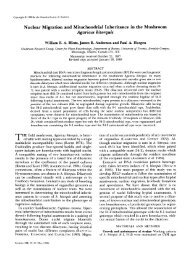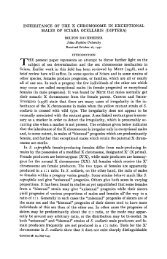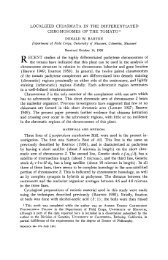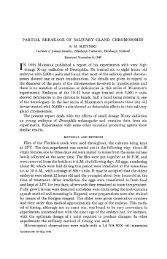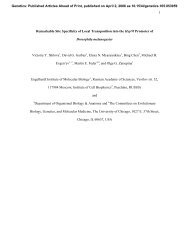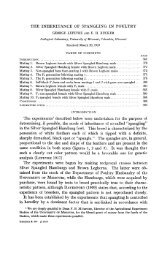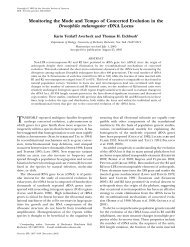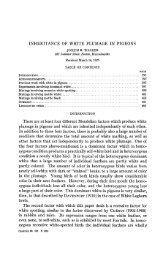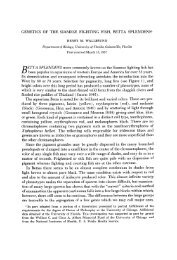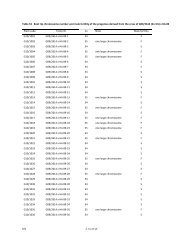abstracts of papers presented at the 1962 meetings - Genetics
abstracts of papers presented at the 1962 meetings - Genetics
abstracts of papers presented at the 1962 meetings - Genetics
Create successful ePaper yourself
Turn your PDF publications into a flip-book with our unique Google optimized e-Paper software.
ABSTRACTS 985<br />
infected. Because virus nucleic acid, unprotected by virus protein, is known to be extremely<br />
labile to <strong>the</strong> action <strong>of</strong> ribonucleases, <strong>the</strong> tobacco seedlings exhibiting symptoms were tested for<br />
ease <strong>of</strong> transmission <strong>of</strong> <strong>the</strong> infection to local lesion hosts in <strong>the</strong> presence <strong>of</strong> a small amount <strong>of</strong><br />
pancre<strong>at</strong>ic ribonuclease. Of 155 tobacco seedlings inocul<strong>at</strong>ed, 72 exhibited visible signs <strong>of</strong> virus<br />
infection and <strong>of</strong> <strong>the</strong>se two behaved peculiarly in th<strong>at</strong> it was difficult to transfer <strong>the</strong> infection by<br />
standard techniques. Phenol extracts <strong>of</strong> <strong>the</strong>se two plants contained infectivity whereas buffer<br />
extracts contained little or none. Extracts made by <strong>the</strong> technique <strong>of</strong> DIENER (Virology 16: 140,<br />
<strong>1962</strong>) which is designed to yield both intact virus and free infectious ribonucleic acid, yielded<br />
only ribonuclease-sensitive infectivity. The lack <strong>of</strong> ablity to induce <strong>the</strong> syn<strong>the</strong>sis <strong>of</strong> virus protein<br />
does not, apparently, limit <strong>the</strong> replic<strong>at</strong>ing ability <strong>of</strong> <strong>the</strong> virus nucleic acid in <strong>the</strong> host cell nor <strong>the</strong><br />
spread <strong>of</strong> <strong>the</strong> infectious principle from cell to cell.<br />
SIMANTEL, G. M., J. G. Ross, C. C. HUANG, and H. D. HAENSEL, South Dakota St<strong>at</strong>e College,<br />
Brookings, South Dakota: Som<strong>at</strong>ic chromosome reduction in sorghum after colchicine tre<strong>at</strong>ment.<br />
-Following tre<strong>at</strong>ment <strong>of</strong> sorghum seedlings <strong>of</strong> <strong>the</strong> variety “Experimental 3” with colchicine,<br />
diploid mutant plants arise th<strong>at</strong> breed true in subsequent gener<strong>at</strong>ions. The production <strong>of</strong> diploid<br />
mutants was found to be dependent upon <strong>the</strong> genotype as well as <strong>the</strong> presence <strong>of</strong> certain environmental<br />
conditions after colchicine applic<strong>at</strong>ion. To explain <strong>the</strong> homozygosity <strong>of</strong> <strong>the</strong> mutants, it<br />
has been proposed th<strong>at</strong> a reduction <strong>of</strong> chromosomes to a haploid condition occurred with l<strong>at</strong>er<br />
doubling to restore <strong>the</strong> diploid number. This was tested by tre<strong>at</strong>ing seedlings heterozygous for<br />
chromosome markers (reciprocal transloc<strong>at</strong>ions) .-After tre<strong>at</strong>ment <strong>of</strong> 80 seedlings heterozygous<br />
for <strong>the</strong> chromosome marker, three diploid mutants occurred. Since <strong>the</strong>se mutant plants when<br />
examined <strong>at</strong> diakinesis showed no configur<strong>at</strong>ion <strong>of</strong> four chromosomes, <strong>the</strong>y must have been<br />
homozygous <strong>at</strong> least for <strong>the</strong> two pairs <strong>of</strong> marked chromosomes. They had uniformly high seed<br />
set in comparison to <strong>the</strong> semisterility noted in <strong>the</strong> o<strong>the</strong>r plants. The marked chromosomes <strong>of</strong><br />
two <strong>of</strong> <strong>the</strong>se mutants were demonstr<strong>at</strong>ed to be same as <strong>the</strong> normal parent (male). The homozygosity,<br />
<strong>the</strong>refore, could not have arisen as a result <strong>of</strong> se1fing.-The presence <strong>of</strong> homozygous<br />
normal chromosomes identified in <strong>the</strong> mutants obtained after colchicine tre<strong>at</strong>ment demonstr<strong>at</strong>es<br />
<strong>the</strong> occurrence <strong>of</strong> som<strong>at</strong>ic chromosome reduction followed by doubling, <strong>of</strong> <strong>at</strong> least <strong>the</strong> two marked<br />
chromosomes followed in this study. It would be expected th<strong>at</strong> <strong>the</strong> whole chromosome complement<br />
would be involved in such a som<strong>at</strong>ic reduction to explain <strong>the</strong> phenomenon <strong>of</strong> <strong>the</strong> appearance<br />
<strong>of</strong> true-breeding mutants after colchicine tre<strong>at</strong>ment. (This investig<strong>at</strong>ion was supported in<br />
part by research grants from <strong>the</strong> N<strong>at</strong>ional Cancer Institute, U. S. Public Health Service (C2086)<br />
and <strong>the</strong> N<strong>at</strong>ional Science Found<strong>at</strong>ion.)<br />
SMITH, HAROLD H., Department <strong>of</strong> Biology, Brookhaven N<strong>at</strong>ional Labor<strong>at</strong>ory, Upton, L. I.,<br />
N. Y.: Studies on <strong>the</strong> origin, inheritance and mut<strong>at</strong>ion <strong>of</strong> genic-cytoplasmic male sterility in<br />
Nicotiana.-Second gener<strong>at</strong>ion popul<strong>at</strong>ions <strong>of</strong> <strong>the</strong> cross Nicotiana langsdorffii x N. sanderae<br />
yield approxim<strong>at</strong>ely ten percent male sterile segregants. None appear in <strong>the</strong> parental species,<br />
reciprocal backcrosses <strong>of</strong> <strong>the</strong> F, to ei<strong>the</strong>r parent, or in F, progeny <strong>of</strong> <strong>the</strong> reciprocal F, hybrid.<br />
Experimental results were comp<strong>at</strong>ible with <strong>the</strong> hypo<strong>the</strong>sis th<strong>at</strong> male sterility is controlled in this<br />
m<strong>at</strong>erial by a cytoplasmic factor [ms], present only in N. langsdorffii; and two independent recessive<br />
alleles, one contributed by each parent species. The dominant alleles, Rf, and Rf,, restore<br />
pollen fertility. N. langsdorfii is [ms] Rf,Rf,rf,rf,; N. sanderae is [MF] rflrflRfeRfZ, and only<br />
[ms] rf,rf,rf,rf, segregants are male sterile. The rf, allele is linked with approxim<strong>at</strong>ely 13%<br />
crossing-over to p, a gene from N. 1angsdorfiCii th<strong>at</strong> inhibits anthocyanin pigment<strong>at</strong>ion. Pollen<br />
carrying <strong>the</strong> Rf, allele is <strong>at</strong> a disadvantage <strong>of</strong> about 1:4 in competition with rf, pollen. This<br />
accounts for certain anomalous r<strong>at</strong>ios observed as, e.g. ten percent than 6.25% male steriles in<br />
<strong>the</strong> F,. Two genotypes were syn<strong>the</strong>sized to study induced mut<strong>at</strong>ion <strong>of</strong> <strong>the</strong> cytoplasmic factor,<br />
namely: male fertile [MF] rf,rf,rf,dz and male sterile [ms] rf,rf,rf,rf,. Plants <strong>of</strong> each were<br />
exposed to chromic gamma irradi<strong>at</strong>ion <strong>of</strong> 100dday and seeds to 10,OOOr <strong>of</strong> acute gamma radi<strong>at</strong>ion.<br />
Results <strong>of</strong> efforts to mut<strong>at</strong>e [MF] rjlrflrferj, to [ms] rf,rj,rj,rj, and vice versa will be reported.





